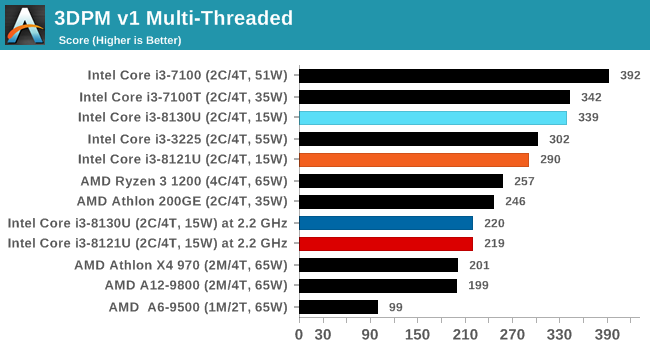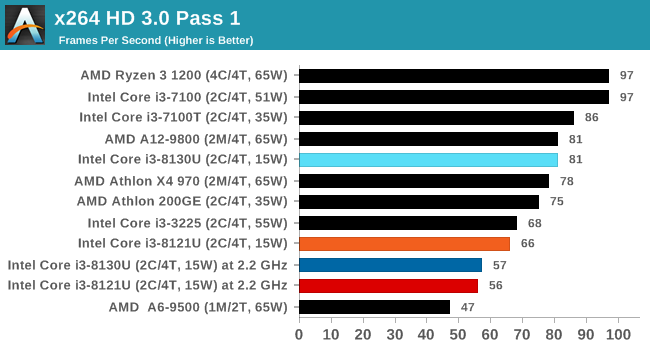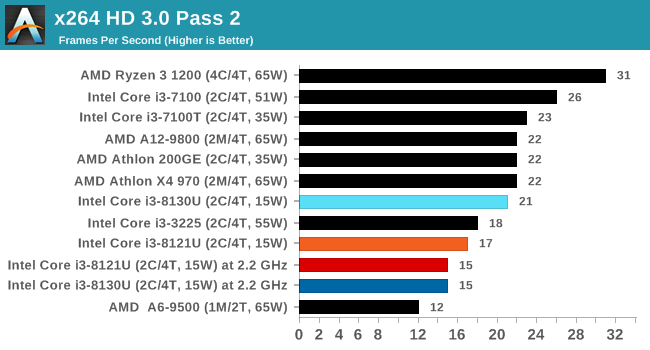Intel's 10nm Cannon Lake and Core i3-8121U Deep Dive Review
by Ian Cutress on January 25, 2019 10:30 AM ESTStock CPU Performance: Legacy Tests
We have also included our legacy benchmarks in this section, representing a stack of older code for popular benchmarks.
All of our benchmark results can also be found in our benchmark engine, Bench.
3DPM v1: Naïve Code Variant of 3DPM v2.1
The first legacy test in the suite is the first version of our 3DPM benchmark. This is the ultimate naïve version of the code, as if it was written by scientist with no knowledge of how computer hardware, compilers, or optimization works (which in fact, it was at the start). This represents a large body of scientific simulation out in the wild, where getting the answer is more important than it being fast (getting a result in 4 days is acceptable if it’s correct, rather than sending someone away for a year to learn to code and getting the result in 5 minutes).
In this version, the only real optimization was in the compiler flags (-O2, -fp:fast), compiling it in release mode, and enabling OpenMP in the main compute loops. The loops were not configured for function size, and one of the key slowdowns is false sharing in the cache. It also has long dependency chains based on the random number generation, which leads to relatively poor performance on specific compute microarchitectures.
3DPM v1 can be downloaded with our 3DPM v2 code here: 3DPMv2.1.rar (13.0 MB)


x264 HD 3.0: Older Transcode Test
This transcoding test is super old, and was used by Anand back in the day of Pentium 4 and Athlon II processors. Here a standardized 720p video is transcoded with a two-pass conversion, with the benchmark showing the frames-per-second of each pass. This benchmark is single-threaded, and between some micro-architectures we seem to actually hit an instructions-per-clock wall.












129 Comments
View All Comments
MrCommunistGen - Friday, January 25, 2019 - link
Normally I try to read the whole article (and I *am* looking forward to reading the rest of it) but I already have 2 comments:1. Maybe this review has been in progress for quite a while, but you can definitely buy the NUC8i3CYSM NUC on Amazon, at least in the US. It is shipped and sold by Amazon not some random 3rd party too. It is expensive ($530), and can only be bought with up to 8GB of soldered down RAM, but you can buy it.
2. While the Wi-Fi card is M.2, Lenovo (like HP and others) usually restricts what Wi-Fi cards can be used with a BIOS/UEFI whitelist. I guess this might not apply to a China-only model, but I wouldn't just assume that the card can be upgraded down the line unless you've already verified this is possible.
jaju123 - Friday, January 25, 2019 - link
I would chalk up the system resonsiveness to the GPU and the low screen res. When moving from a Dell XPS 15 9560 laptop with 1080p screen resolution to an otherwise identical 4K model, I noticed a severe loss of performance in the windows UI. The reality is that Intel iGPUs in even kaby lake processors are simply not enough to provide a smooth experience on high res laptops. The 1080p experience was really smooth, however.You can also force certain apps to the use the dedicated nvidia graphics, or simply choose to run at a non-native 1080p and it speeds up the UI drastically.
hansmuff - Friday, January 25, 2019 - link
Wow, this is an excellent article. Packed with knowledge and facts, well written; a real gem. Thank you!FreckledTrout - Friday, January 25, 2019 - link
Its weird to see a dual core even in a laptop on the new 10nm process. I would have expected dual cores to disappear with Intel's 10nm or AMD's 7nm.FreckledTrout - Friday, January 25, 2019 - link
The first dual core laptop came out in 2015 with the AMD Athlon 64 X2 4800 so it's just weird to me 14 years later it's still something being made especially with such a dense process.FreckledTrout - Friday, January 25, 2019 - link
Damn no edit.... in 2005 I meant.jeremyshaw - Friday, January 25, 2019 - link
I think I had one of those in a Sharp laptop. It had horrible VIA S3 graphics, but a beautiful, bright display. It was my last 4:3 laptop, an end of an era for me.Icehawk - Saturday, January 26, 2019 - link
Majority of laptops are still DC, I have to check our laptop orders when we place them to make sure my boss and our vendor aren’t screwing up ordering them.ianmills - Friday, January 25, 2019 - link
Intel probably thought the same as you! Remember the reason this was released was so that Intel could tell its investors it was shipping 10nm partsdanwat1234 - Friday, January 25, 2019 - link
Agreed.